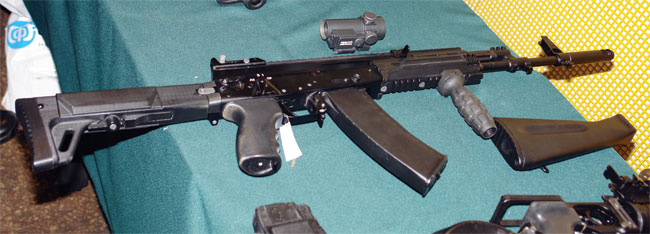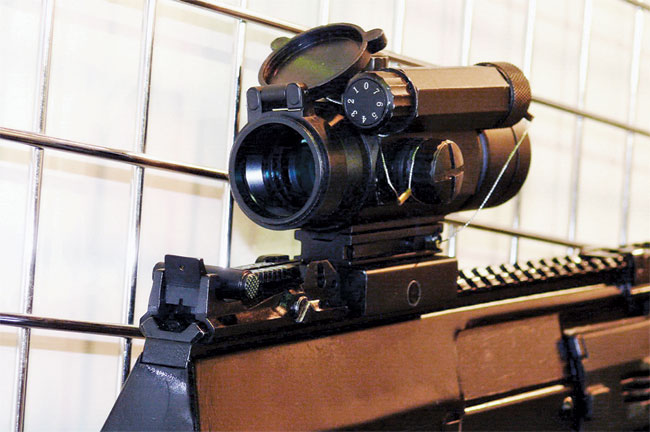The Russians still say that the 65 year old Avtomat Kalashnikova would soldier on for decades, yet they are painfully aware that it’s getting out of touch with modernity – despite numerous modernizations. That’s precisely why they created the AK-12, or 5th Generation Avtomat Kalashnikova, presented in January 2012.
The AK-100 series successor wasn’t created overnight – the first models were already evaluated by 2009. The new rifle even got designated then as the AK-200 – but still arguments abounded whether that should be another modified 100-series rifle with rails all over, or a totally new design.
In July 2010, the first press statement told everybody to prepare for a revolution soon to come – a totally new modular design, a new opening in the long career of the AK. It was said to enable exchanging bolts and barrels, shoot different cartridges, to have enhanced ergonomics, better functionality and to be good enough to challenge the best that the West was able to muster. It was also said that the Russian Defence Ministry was very much interested in the new weapon, taking an active part in shaping the new design, and purportedly even contracted the Izhevsk plant for the AK-100 series wholesale replacement.

Then traditional silence fell, and on January 24, 2012 the new Avtomat was shown to the public for the first time amongst much fanfare. The new design, created by the Izhmash’s chief designer, Vladimir Viktorovich Zlobin, was designated the “AK-12,” for “Avtomat Kalashnikova Model 2012.”
Four months later another presentation took place, but this time for a chosen few, at a closed meeting of the Interministerial Working Group of the Military-Industrial Laboratories Committee in Solnechnogorsk on Lake Senezh, 65 kilometers from Moscow. The participants, representatives of the Defense and Internal Affairs Ministries, as well as Federal Security Servicemen, were able not only to look at, but shoot the new rifle as well.
In common opinion, the AK-12 has a much milder recoil and muzzle jump than the predecessors. Nevertheless, numerous modifications and changes were requested, most of them arising from input by the special forces users that were in attendance at the presentation. The Izhmash representative promised all would be implemented by the end of 2012.

New, Yet Old
Those who expected miracles could be disappointed by the weapon’s appearance. AK-12 has some minor ‘loans’ from the FN SCAR or the Czech Sa-58, but even with the naked eye one can see the AK heritage.
It still remained a gas-operated long-stroke piston selective-fire rifle with the gas tube above the barrel. The bolt carrier is connected with the operating rod and the gas piston is at the front end of the op-rod. It fires from a closed bolt; this bolt being set into a bolt carrier, and locks to the receiver trunnion by turning to the right. The fire control group has an internal hammer, and all the other innards, automatic sear, disconnector and trigger operate in the same manner as in the AK-74.
Novelties
The most important novel feature of the AK-12 is the caliber-swap concept. The AK-12 receiver is said to have been re-designed to allow barrel-swapping and thus caliber-changing (but honestly, it doesn’t look like it changed much, and certainly no quick-change features are present). The basic version (and the only one so far demonstrated) is chambered for the 5.45mm x 39, but it can be changed to the original AK round, the 7.62mm x 39, or the 5.56mm x 45. The advertisement indicates also the 7.62mm x 51 NATO round, but it seems highly unlikely that such a big and powerful round could be fired in the same receiver – probably another set of building blocks would be needed, just like with the SCAR-L/SCAR-H or HK416/417. Also, 6.5mm Grendel or 6.8 Rem SPC were speculated as possible chamberings as well, but so far nothing official has been said about them. The factory statements predict a wide variety of possible configurations, with different barrels, different calibers, different FCGs, different stocks, for military, police, civilian-legal semi-only, etc.

The ergonomics has been greatly enhanced in comparison to the predecessors. The telescoping stock is foldable to the side (left or right, whatever the need of the user) and set in-line with the barrel axis to reduce muzzle jump. The stock latch is the part of the stock itself, not the rifle, thus enabling easy reversing of the stock folding direction. For export to where folding stocks are deemed ‘non-sporting,’ the latch can be easily disabled or the stock can be exchanged for a solid, non-folding variation. The rubber-clad cheek-piece and butt-plate are height-adjustable. A new muzzle device has a standard 22 mm external diameter to enable rifle grenade use.
The cocking handle has been relocated significantly to the front, and can be fitted from left or right, according to the shooter’s wishes. The receiver cover is all new, much sturdier and hinged at the front, with an integral 1913 rail all along the top. At the rear end of the rail a tangent sight with a peep hole (for aiming with a stock) and notch (for aiming while shooting from the sling with butt folded) is attached to the top rail. There are more rails as well: on top of the handguard (in-line with the cover rail), and even on top of the gas block. The handguard also has rails on the sides and at the bottom. Lugs under the gas chamber and front sight holder are intended for an underbarrel grenade launcher (GP-25, -30 or -34) (the former) and bayonet attachment (the latter).

The receiver cover latch is actuated by the lever on the right above pistol grip. Right in front of it another totally new lever-style control is situated – a four-position safety/fire selector. The positions are: ‘ΠΡ’ (=PR, for Predokhranyeniy, SAFE), ‘1’ or ‘O’ (for Odinochniy, SEMI), ‘3’ for 3-round BURST and ‘AB’ (AV for Avtomaticheskiy, AUTO). This lever has replaced the legendary Kalashnikov safety-selector-dust cover (itself a ‘loan’ from John Moses Browning’s Remington Model 8 rifle). Theoretical rate of fire in fully automatic firing is 600 rpm, but is said to rise up to 1,000 rpm in 3-round bursts.
Other controls are located in the front part of the trigger guard. The magazine latch is classical in appearance, but it said to be redesigned to enable magazine release with the trigger finger. The oval buttons above are bolt catch actuators – another big-time novelty in the AK-12. The bolt catch is mostly manually-actuated, for inspection purposes, as the hitherto introduced magazines lack the bolt catch actuator projection on their followers. The 5.45mm AK-12 takes all AK-74M-compatible 30-round magazines, as well as RPK-74 45-round magazines. The 7.62mm variant would also take all AK/AKM/RPK magazines, of 30-, 40- and 75-round capacity. New types of magazines introduced with the AK-12 comprise a new 30-round magazine with bolt-catch actuator, 60-round quad-stack banana and a 95-round drum.
Carbine (AK-12U), 9mm submachine gun (PPK-12), Designated Marksman Rifle (SVK-12), and Light Machine Gun (RPK-12) versions of the AK-12 are also planned, as well as a semiautomatic-only civilian export version.

Now What?
No one seems to know what’s next. The future awaiting the AK-12 seems hardly bright, so far. The MoD has ordered a test batch and the testing is already under way. Only when it is done can a decision be made whether the Russian Army would re-arm – or wait a little longer for another new rifle. The security forces are also testing the AK-12 and carefully select the wording of their press releases so as not to put themselves in any awkward commitment. Only the manufacturer is sure to have the rifle in full production for the country’s military – and soon, ‘at the latest in FY2013.’ Whether it would be so depends on the will of Izhmash’s main client: the Army of the Russian Federation. And the Army, even though it ordered a test batch, seems to be neither overly impressed with the new rifle nor interested in it. In 2011, for the very first time, the Army did not buy a single Kalashnikov assault rifle, and is openly referring to it as ‘obsolete.’ The military does not want any more Kalashnikovs – they already have as many as 17 million of these in its mobilization stocks, counting both older 7.62 mm AKM and newer 5.45mm AK-74 variants. The ministry representative once mused that, “We already have enough Kalashnikovs to wage several world wars,” and although his quip was quickly glossed over by his superiors, it seems to voice the general attitude toward the once iconic Comrade Rifle.
The AK-12 was created and financed with Izhmash’s own money and the company vows to find remuneration in the international markets, including a civilian one, if the Army won’t budge. There seems to be a big sales potential, given the popularity of AK-tuning throughout the world. Thus, the opportunity may come to have a factory-tuned Avtomat Kalashnikova-PIP, right straight from the original manufacturer, bristling with 1913-rails, enhanced ergonomics, fully ambidextrous, fitted with a bolt hold-open and all the bells and whistles.
– AK-12 SPECIFICATIONS –
Caliber: 5.45 mm x 39
Length, O/A, stock extended: 945 mm
Length, O/A, stock folded: 725 mm
Barrel length (bore only): 415 mm
Sighting radius: 583 mm
Weight, w/o magazine: 3.3 kg
Weight, empty 30-rd magazine: 0.23 kg
Weight, empty 60-rd magazine: 0.33 kg
Weight, empty 95-rd magazine: 1.0 kg
Max. sighting range: 1,000 m
Rate of fire (theor.): 600 (FA)/1,000 (3-rd burst) rpm









